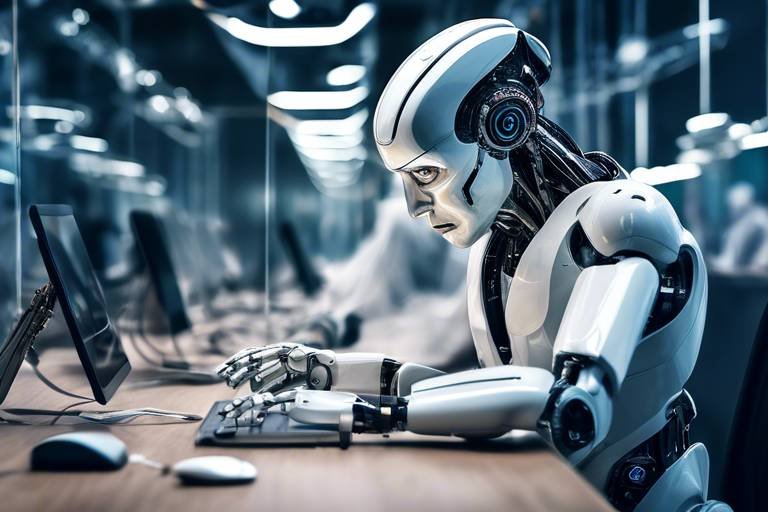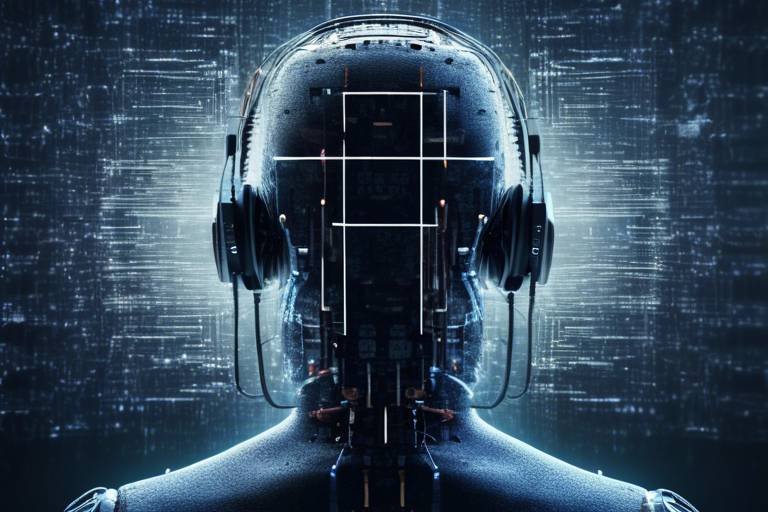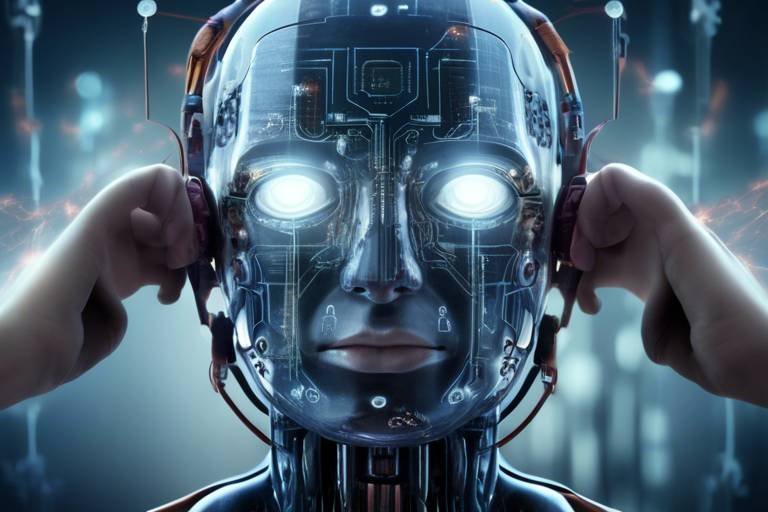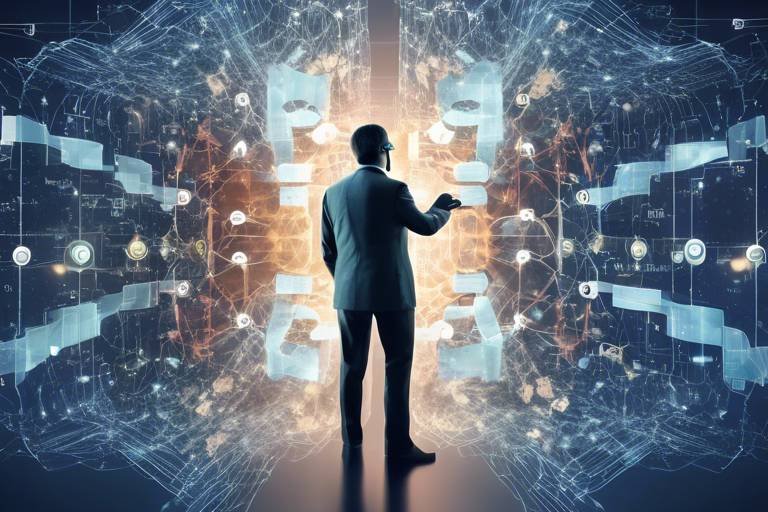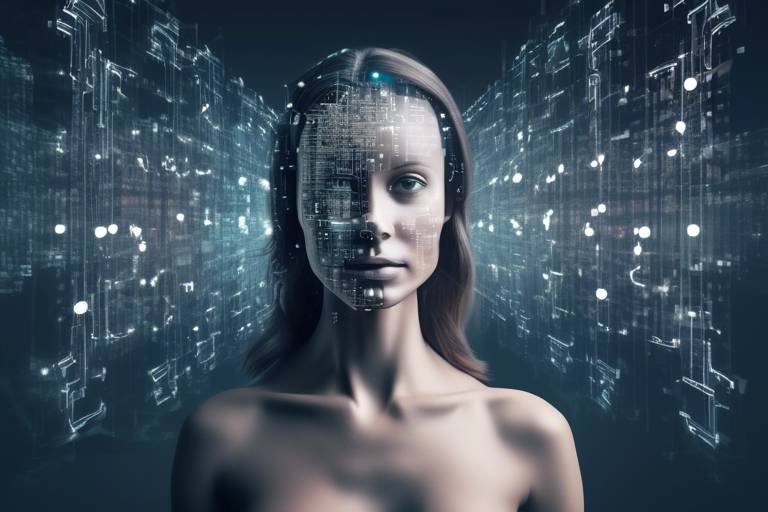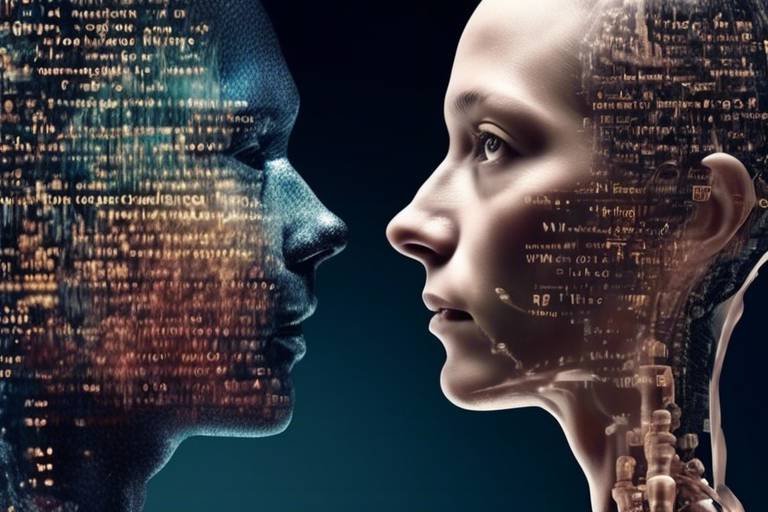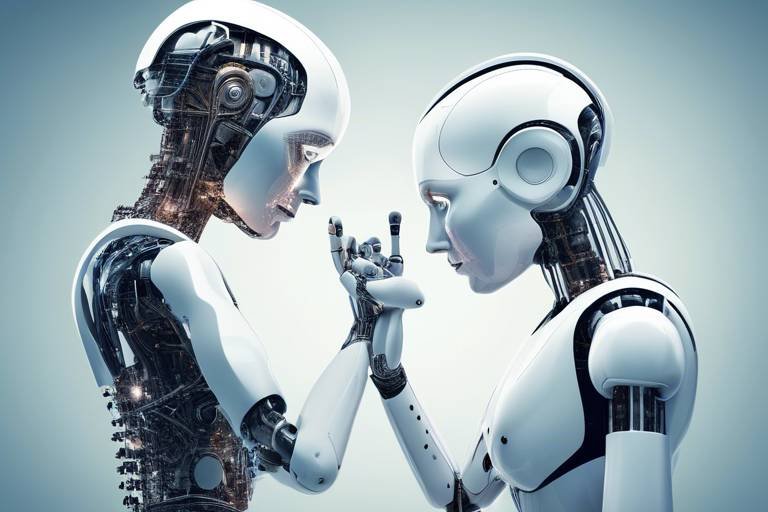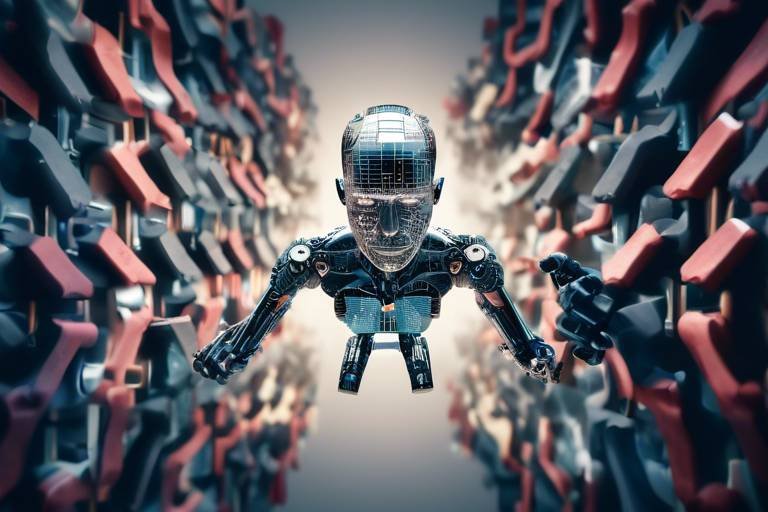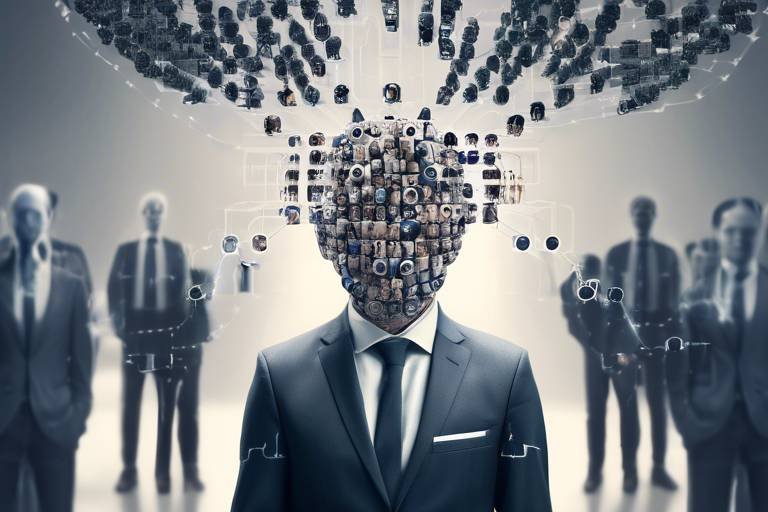Future of Work: Humans Working Alongside AI
The world of work is undergoing a seismic shift, one that feels like we’re living in a sci-fi movie. With artificial intelligence (AI) becoming a household name, it’s reshaping how we think about our jobs, our roles, and even our identities in the workplace. Have you ever imagined a future where humans and machines collaborate seamlessly, each enhancing the capabilities of the other? This isn't just a dream—it's happening right now! As we delve deeper into this fascinating topic, we’ll explore how AI is transforming traditional job roles and workflows, creating a new era of productivity and innovation.
AI technology is not just a passing trend; it’s rapidly being integrated into various sectors, from healthcare to finance and beyond. This integration is akin to adding a turbocharger to a car—it enhances performance and efficiency. Businesses are leveraging AI to streamline operations, improve customer service, and make data-driven decisions. But what does this mean for the workforce? As AI takes over repetitive tasks, employees are finding themselves freed up to focus on more complex and creative aspects of their jobs. This shift is not just about replacing human labor; it’s about transforming the very nature of work itself.
In this new landscape, collaboration between humans and AI is not just beneficial; it's essential. Imagine a symphony where each musician plays their part flawlessly, creating a beautiful harmony. Similarly, when humans work alongside AI, they can achieve remarkable results. Effective partnerships can enhance productivity and spur innovation in ways we’ve never seen before. But how exactly does this collaboration unfold in real-world scenarios?
One of the most significant advantages of AI is its ability to analyze vast amounts of data quickly. Picture this: a business leader faced with a mountain of information has to make a critical decision. Instead of sifting through spreadsheets for hours, they can utilize AI systems that provide data-driven insights in real-time. These insights not only aid human decision-making but also ensure that choices are informed and strategic. It’s like having a super-smart assistant at your fingertips, ready to crunch numbers and reveal patterns that would take humans much longer to uncover.
Leveraging AI for data analysis allows organizations to uncover trends and patterns that might otherwise go unnoticed. For example, in retail, AI can analyze customer purchasing behavior to predict future trends. This empowers businesses to adjust their strategies proactively. The benefits of these data-driven insights in strategic planning are immense; they lead to better resource allocation, optimized marketing campaigns, and ultimately, higher profitability.
AI-powered real-time analytics are game-changers for businesses. Imagine being able to respond to market changes as they happen, rather than after the fact. This capability enhances operational efficiency, allowing companies to pivot quickly in response to customer needs or market fluctuations. It’s like having a crystal ball that shows you what’s coming next, enabling you to stay one step ahead of the competition.
Contrary to the fear that AI will replace human jobs, it can actually complement human skills. Think of AI as a tool that enhances creativity, problem-solving, and interpersonal skills in the workforce. For instance, AI can handle mundane tasks, allowing employees to invest their time in brainstorming innovative ideas or building stronger relationships with clients. This symbiosis not only boosts morale but also leads to a more engaged and productive workforce.
As AI continues to evolve, it’s reshaping job descriptions and creating entirely new roles. This transformation is akin to the industrial revolution, where new technologies led to the emergence of jobs that didn’t exist before. The integration of AI is not just about changing existing roles; it’s about creating opportunities in fields we never imagined. So, what does this mean for job seekers and employees?
As AI technology evolves, new job categories are emerging, such as AI trainers, data analysts, and AI ethicists. These roles are becoming increasingly vital as businesses seek to harness the power of AI while ensuring ethical practices. The landscape is shifting, and those who are adaptable and willing to learn will find themselves in high demand.
To thrive in this AI-driven world, reskilling and upskilling are essential. Continuous learning is no longer optional; it’s a necessity. Companies are investing in training programs to help employees acquire new skills that align with AI advancements. This commitment to learning ensures that employees remain relevant in the job market, ready to tackle the challenges and opportunities that AI presents.
- Will AI take away my job? While AI may automate certain tasks, it also creates new opportunities and roles that require human skills.
- How can I prepare for a future with AI? Focus on developing skills that complement AI, such as creativity, critical thinking, and emotional intelligence.
- What industries will be most affected by AI? Sectors like healthcare, finance, and manufacturing are experiencing significant transformations due to AI.

The Rise of AI in the Workplace
The advent of Artificial Intelligence (AI) has sparked a revolution in the workplace, reshaping how we think about productivity and efficiency. Gone are the days when AI was merely a concept confined to science fiction; today, it's a reality that's rapidly transforming various industries. From manufacturing to finance, AI is being integrated into everyday operations, and the impact is profound. But what exactly does this mean for the workforce?
As AI technology becomes more sophisticated, its adoption across industries is accelerating. Companies are increasingly leveraging AI to automate mundane tasks, analyze data, and enhance decision-making processes. For instance, in the realm of customer service, AI-powered chatbots can handle inquiries 24/7, freeing up human employees to focus on more complex issues that require emotional intelligence and creativity. This shift not only boosts productivity but also allows businesses to allocate resources more efficiently.
The integration of AI is not just about replacing human effort; it's about augmenting it. In fact, studies have shown that organizations that embrace AI experience a significant increase in operational efficiency. According to a recent report by McKinsey, companies that implement AI can boost their productivity by as much as 40%. This statistic underscores the importance of AI as a catalyst for growth and innovation in the workplace.
Moreover, the rise of AI is creating a more data-driven environment. Businesses now have access to vast amounts of information, which can be analyzed to uncover insights that were previously unattainable. For example, AI algorithms can sift through customer data to identify purchasing trends, enabling companies to tailor their marketing strategies more effectively. This ability to harness data not only enhances decision-making but also allows organizations to stay ahead of the competition.
However, the transition to an AI-driven workplace isn't without its challenges. Many employees express concerns about job security and the potential for AI to replace their roles. While it's true that some jobs may become obsolete, it's essential to recognize that new opportunities will also emerge as a result of this technological shift. For instance, roles focused on AI management, data analysis, and machine learning are becoming increasingly important.
In conclusion, the rise of AI in the workplace is not just a trend; it's a fundamental shift in how we work. By embracing AI technologies, organizations can enhance productivity, improve decision-making, and create new job opportunities. As we move forward, the key will be to foster a collaborative environment where humans and AI can work together harmoniously, driving innovation and success.

Collaboration Between Humans and AI
The future of work is all about collaboration, and when we talk about collaboration, we can't ignore the dynamic duo of humans and artificial intelligence (AI). Imagine a world where machines enhance our capabilities rather than replace them. This partnership is not just a futuristic dream; it's happening right now in various industries. As AI technology becomes more sophisticated, it opens up a realm of possibilities that can significantly boost productivity and innovation in the workplace.
So, how does this collaboration work? Well, think of AI as your trusty sidekick, ready to assist you in tasks that require heavy lifting—literally and figuratively. By leveraging AI, humans can focus on what they do best: creativity, strategic thinking, and emotional intelligence. This partnership allows for a more efficient workflow where each entity plays to its strengths. For instance, while AI can crunch numbers and analyze data at lightning speed, humans can interpret that data, infuse it with context, and make decisions based on intuition and experience.
One of the most exciting aspects of this collaboration is how it enhances decision-making. AI systems are capable of sifting through mountains of data to provide insights that we, as humans, might overlook. Imagine a financial analyst who, with the help of AI, can identify trends and anomalies in real time. This means that decisions are not just based on gut feelings but are supported by solid data. As a result, businesses can pivot quickly and make informed choices that drive success.
When we talk about data-driven insights, we're diving into the treasure trove of information that AI can uncover. AI tools can analyze historical data and predict future trends, enabling organizations to strategize effectively. For example, a retail company can use AI to analyze customer purchasing patterns, allowing them to tailor marketing strategies that resonate with their audience. This not only enhances the customer experience but also boosts sales. Here are some key benefits of leveraging AI for data analysis:
- Improved Accuracy: AI minimizes human error in data interpretation.
- Faster Analysis: What used to take days can now be accomplished in minutes.
- Identifying Hidden Opportunities: AI can spot trends that may not be immediately obvious to human analysts.
In today's fast-paced business environment, real-time analytics is a game-changer. AI-powered analytics tools allow organizations to monitor key performance indicators as they happen. This immediacy enables businesses to respond swiftly to changes in the market, customer behavior, or internal processes. For instance, a logistics company can use AI to track shipments in real-time, ensuring that deliveries are made on time and optimizing routes to save costs. This level of responsiveness can significantly enhance operational efficiency and customer satisfaction.
Moreover, the collaboration between humans and AI fosters a culture of innovation. When employees feel empowered to use AI tools, they are more likely to experiment and push boundaries. This environment encourages creative problem-solving, where teams can brainstorm ideas while AI handles the data-heavy lifting. The result? A workplace that thrives on collaboration, creativity, and efficiency.
In essence, the collaboration between humans and AI is not just about coexisting; it’s about creating a synergy that enhances productivity and drives innovation. As we embrace this partnership, we must also recognize the importance of adapting our skills to work alongside these intelligent systems. This evolution is crucial for not just surviving but thriving in the future of work.
- What are the main benefits of AI collaboration in the workplace?
AI collaboration enhances productivity, supports better decision-making, and fosters a culture of innovation. - Will AI replace human jobs?
While AI may transform certain job roles, it is more likely to augment human skills rather than replace them. - How can employees prepare for working with AI?
Continuous learning and upskilling are essential to adapt to AI advancements and remain relevant in the job market.

Enhancing Decision-Making
In today's fast-paced business environment, the ability to make informed decisions quickly is paramount. This is where AI systems come into play, acting as powerful allies in the decision-making process. Imagine having a trusty sidekick that can sift through mountains of data in a fraction of the time it would take a human. That’s exactly what AI does! By analyzing vast datasets, AI tools provide actionable insights that help leaders make better choices. This partnership between humans and AI is not only beneficial but essential for staying competitive in the market.
One of the most significant advantages of using AI in decision-making is its capability to identify patterns and trends that may not be immediately obvious to human analysts. For instance, consider a retail company that uses AI to analyze consumer purchasing behavior. By examining historical sales data, AI can predict future trends, helping businesses stock the right products at the right time. This predictive capability means that companies can not only enhance their inventory management but also tailor their marketing strategies to align with consumer preferences.
Moreover, AI tools can offer data-driven insights that are crucial for strategic planning. These insights help organizations to:
- Identify new market opportunities
- Assess risks more accurately
- Optimize resource allocation
Another key feature of AI in decision-making is its ability to provide real-time analytics. In an age where information is constantly changing, having access to real-time data can be a game-changer. For example, a financial institution can utilize AI to monitor stock market fluctuations and provide instant recommendations to traders. This immediacy not only enhances operational efficiency but also allows businesses to respond swiftly to market changes, thereby gaining a significant edge over competitors who may still be relying on outdated information.
In conclusion, the integration of AI into decision-making processes is transforming how businesses operate. By enhancing decision-making capabilities through data analysis and real-time insights, AI empowers organizations to make smarter, faster, and more strategic choices. As we continue to embrace this technology, the partnership between humans and AI will only grow stronger, leading to more innovative solutions and improved outcomes across industries.

Data-Driven Insights
In today’s fast-paced business environment, have become more than just a buzzword; they are the cornerstone of strategic decision-making. With the integration of AI technologies, organizations can now sift through massive datasets to uncover trends and patterns that were previously hidden from view. Imagine having a magic lens that allows you to see not just what happened in the past, but also what might happen in the future. That’s exactly what AI offers businesses.
AI systems excel at analyzing data, providing insights that are both timely and relevant. This capability allows decision-makers to pivot their strategies based on real-time information. For instance, a retailer can track customer purchasing behavior and adjust inventory levels almost instantaneously, ensuring that popular items are always in stock. This kind of agility can be the difference between a thriving business and one that struggles to keep up with market demands.
Consider the following benefits of leveraging AI for data analysis:
- Improved Accuracy: AI minimizes human error by processing data with precision, leading to more reliable insights.
- Faster Analysis: What used to take days or weeks can now be accomplished in mere minutes, allowing businesses to act swiftly.
- Predictive Capabilities: AI can forecast trends by analyzing historical data, enabling proactive decision-making.
Moreover, organizations that harness data-driven insights can create a culture of continuous improvement. With AI tools at their disposal, teams can regularly evaluate their performance against key metrics and make necessary adjustments. This iterative process fosters a mindset of innovation, where employees are encouraged to experiment and learn from both successes and failures.
In summary, data-driven insights powered by AI are revolutionizing how businesses operate. By providing accurate, timely, and actionable information, AI not only enhances decision-making but also equips organizations with the tools they need to stay ahead in a competitive landscape. As we move forward, the ability to leverage these insights will be crucial for any organization looking to thrive in the age of AI.
- What are data-driven insights? Data-driven insights are conclusions drawn from analyzing data, which help organizations make informed decisions.
- How does AI improve data analysis? AI enhances data analysis by processing large volumes of data quickly and accurately, revealing patterns and trends.
- Why are data-driven insights important for businesses? They enable businesses to make strategic decisions based on evidence rather than intuition, improving overall performance.

Real-Time Analytics
In today's fast-paced business environment, has become a game-changer for organizations striving to maintain a competitive edge. Imagine being able to access critical data at the blink of an eye—this capability allows businesses to make informed decisions almost instantaneously. Rather than waiting for end-of-day reports or weekly summaries, companies can now tap into live data streams, enabling them to respond to market changes, customer preferences, and operational challenges as they happen.
But what exactly does real-time analytics entail? It's all about collecting, analyzing, and visualizing data in the moment. This means that businesses can detect trends and patterns while they are still unfolding, which is like having a crystal ball that reveals the future of your market dynamics. For instance, a retail store can adjust its inventory based on current sales data, or a tech company can pivot its marketing strategy based on real-time user engagement metrics. The ability to pivot quickly is crucial; it can mean the difference between seizing an opportunity or missing out entirely.
One of the key components of real-time analytics is the use of advanced technologies such as artificial intelligence and machine learning. These tools can process vast amounts of data in seconds, generating insights that would take a human analyst hours, if not days, to uncover. For example, AI algorithms can analyze customer behavior patterns in real-time, allowing businesses to tailor their offerings to meet immediate demands. This not only enhances customer satisfaction but also boosts overall sales performance.
To illustrate the impact of real-time analytics, consider the following table that highlights its benefits across different sectors:
| Industry | Benefits of Real-Time Analytics |
|---|---|
| Retail | Dynamic inventory management, personalized marketing strategies |
| Healthcare | Immediate patient data tracking, improved treatment outcomes |
| Finance | Real-time fraud detection, instant risk assessment |
| Manufacturing | Enhanced quality control, predictive maintenance |
As you can see, the advantages of real-time analytics span various industries, making it a vital tool for any organization aiming to thrive in today's digital landscape. However, it's also essential to consider the challenges that come with implementing these systems. Organizations must invest in the right technology and ensure that their teams are trained to interpret and act on the data effectively.
In conclusion, real-time analytics is not just a trend; it is a necessity for businesses looking to stay ahead. By leveraging the power of immediate data access, companies can enhance their operational efficiency, improve customer experiences, and drive innovation. The future belongs to those who can harness the insights provided by real-time analytics and turn them into actionable strategies.
- What is real-time analytics? Real-time analytics refers to the process of continuously inputting and analyzing data to provide immediate insights and information.
- How does real-time analytics benefit businesses? It allows businesses to make faster decisions, respond to market changes, and improve customer satisfaction by tailoring services and products to current demands.
- What technologies are used in real-time analytics? Technologies such as artificial intelligence, machine learning, and big data processing tools are commonly used to facilitate real-time analytics.

Augmenting Human Skills
In today's rapidly evolving workplace, the integration of AI technologies is not just about replacing human labor; rather, it's about enhancing and amplifying the skills that make us uniquely human. Imagine AI as a powerful tool, much like a Swiss Army knife, that equips individuals with the capabilities to tackle complex challenges and innovate in ways previously thought impossible. With AI by our side, we can unlock new levels of creativity, problem-solving, and interpersonal skills.
One of the most significant benefits of AI is its ability to enhance creativity. By taking over mundane tasks, AI frees up valuable time for employees to think outside the box and explore innovative solutions. For instance, in creative fields such as marketing or design, AI can analyze consumer trends and preferences, providing insights that inspire unique campaigns or products. This collaboration allows human creativity to flourish, pushing the boundaries of what we thought was achievable.
Moreover, AI can significantly improve problem-solving capabilities. With its advanced data analysis abilities, AI can sift through vast amounts of information and identify patterns that humans might overlook. This can be particularly beneficial in fields like healthcare, where AI systems can analyze patient data to suggest potential diagnoses or treatment plans. As a result, healthcare professionals can make more informed decisions, ultimately leading to better patient outcomes.
Additionally, the rise of AI encourages the development of interpersonal skills. While AI can handle data and analytics, the human touch remains irreplaceable in building relationships and understanding emotional nuances. For example, in customer service roles, AI chatbots can handle basic inquiries, allowing human agents to focus on more complex interactions that require empathy and emotional intelligence. This shift not only enhances the customer experience but also allows employees to hone their communication skills.
In essence, the relationship between humans and AI is not one of competition but rather a collaborative partnership. By leveraging AI's strengths, we can augment our own skills and become more effective in our roles. As we embrace this new era of work, it's crucial to recognize that the future belongs to those who can adapt, learn, and grow alongside these intelligent systems. The key takeaway is that while AI may change the landscape of work, it also opens doors for humans to evolve and thrive in ways we never imagined.
- How does AI enhance creativity in the workplace?
AI can analyze trends and consumer preferences, providing insights that inspire innovative solutions and creative campaigns. - What role does AI play in problem-solving?
AI can process vast amounts of data to identify patterns, helping professionals make informed decisions in their respective fields. - Are interpersonal skills still important with AI in the workplace?
Absolutely! While AI handles data, human interaction remains essential for building relationships and understanding emotions. - How can employees prepare for a future with AI?
Continuous learning, reskilling, and upskilling are crucial for adapting to the evolving job landscape shaped by AI technologies.

Job Transformation and New Roles
The integration of AI into the workplace is not just a trend; it’s a revolution that is fundamentally reshaping the landscape of employment. As machines become more capable of performing tasks that were once solely in the human domain, we are witnessing a significant transformation in job roles. This transformation is akin to a butterfly emerging from a chrysalis—what once was a static job description is now a dynamic and evolving role that requires adaptability and new skills. The question on many minds is: what does this mean for the future of work?
One of the most exciting aspects of this transformation is the emergence of new job categories that didn’t exist a decade ago. Positions like AI Ethicist, Data Curator, and Machine Learning Trainer are becoming increasingly vital. These roles not only highlight the importance of AI in our daily operations but also emphasize the need for human oversight and creativity in AI applications. For example, an AI Ethicist ensures that AI systems operate within ethical boundaries, addressing concerns about bias and fairness. This is crucial as companies strive to maintain their integrity and public trust in an AI-driven world.
Moreover, the transformation isn’t limited to the creation of new roles; it also involves a significant shift in existing job descriptions. Traditional roles are being redefined to incorporate AI tools that enhance productivity and effectiveness. For instance, a marketing manager might now be required to understand data analytics and AI-driven marketing strategies, making them not just a creative leader but also a data-savvy strategist. This blending of skills is essential for navigating the complexities of modern business environments.
To navigate this evolving landscape, reskilling and upskilling have become buzzwords in the corporate world. Organizations are increasingly recognizing that continuous learning is not just beneficial but necessary. Employees need to embrace lifelong learning to stay relevant. For example, a customer service representative might need to learn how to work alongside AI chatbots, understanding when to intervene in a conversation to provide a human touch. This blend of human empathy and AI efficiency creates a more robust customer experience.
| Old Job Role | Transformed Job Role | Skills Required |
|---|---|---|
| Marketing Manager | Data-Driven Marketing Strategist | Data Analysis, AI Tools, Creative Strategy |
| Customer Service Representative | AI-Assisted Customer Experience Specialist | AI Interaction, Problem-Solving, Emotional Intelligence |
| HR Manager | People Analytics Specialist | Data Interpretation, AI in Recruitment, Employee Engagement |
In essence, the future of work is not about humans versus machines; it’s about humans and machines working together in a symbiotic relationship. As we embrace this change, it’s crucial to foster a culture that values adaptability and continuous learning. After all, those who can pivot and grow will not only survive but thrive in this new era of work.
- What new job roles are emerging due to AI?
New roles such as AI Ethicist, Data Curator, and Machine Learning Trainer are becoming prominent as AI technology evolves. - How can employees prepare for job transformations?
Employees can prepare by engaging in reskilling and upskilling opportunities to stay relevant in their fields. - Will AI replace human jobs?
While AI may automate certain tasks, it will also create new roles and enhance existing ones, emphasizing collaboration between humans and machines.

Emerging Job Categories
As we step into a future where artificial intelligence (AI) is not just a tool but a collaborator, the job landscape is undergoing a remarkable transformation. New job categories are emerging, reshaping how we think about work and the skills required to thrive in this evolving environment. Imagine a world where your co-worker is a highly sophisticated AI system, assisting you in tasks that were once solely human domains. Sounds futuristic, right? But this is the reality we're heading towards!
In various industries, roles are being redefined, and new positions are surfacing that blend human creativity with AI efficiency. For instance, consider the rise of AI Ethicists, professionals tasked with ensuring that AI systems operate within ethical boundaries. These individuals will need a deep understanding of both technology and ethical implications, making their role crucial in a world increasingly governed by algorithms.
Another exciting category is that of Data Curators. As organizations generate massive amounts of data, the need for experts who can sift through, categorize, and interpret this information is more critical than ever. Data curators will not only manage data but also provide insights that help organizations make informed decisions. This role is akin to being a librarian in a digital library, where the challenge lies in finding the right information amidst a sea of data.
Moreover, we are witnessing the emergence of AI Trainers. These professionals will be responsible for teaching AI systems how to perform specific tasks effectively. Just as a teacher guides students through learning, AI trainers will ensure that machines understand the nuances of human behavior and decision-making. This role is pivotal in creating systems that are not only efficient but also user-friendly.
Additionally, Human-Machine Teaming Managers are becoming essential in organizations that rely heavily on AI. These managers will oversee the collaboration between human employees and AI systems, ensuring that both parties work harmoniously to achieve common goals. Think of them as conductors of an orchestra, where each musician (human or machine) plays their part to create a beautiful symphony of productivity.
To sum it up, the integration of AI into the workplace is not about replacing human jobs; rather, it’s about creating new opportunities that require a unique blend of skills. As we adapt to this new reality, it’s crucial for professionals to embrace continuous learning and be open to acquiring new competencies. The future of work is bright, and those who are willing to evolve will find themselves in exciting new roles that we can only begin to imagine.
- What are AI Ethicists? AI Ethicists are professionals who ensure that AI systems operate within ethical guidelines and address moral implications of AI usage.
- What role do Data Curators play? Data Curators manage and interpret large sets of data, helping organizations make informed decisions.
- What is the significance of AI Trainers? AI Trainers teach AI systems how to perform specific tasks, ensuring they understand human behavior and decision-making.
- What do Human-Machine Teaming Managers do? They oversee the collaboration between human employees and AI systems to ensure effective teamwork.

Reskilling and Upskilling
The rapid evolution of AI technology is not just a wave of change; it’s a tsunami reshaping the landscape of work as we know it. As machines become more capable, the skills that were once deemed essential are shifting right beneath our feet. This is where the concepts of reskilling and upskilling come into play, acting as lifebuoys for employees navigating these turbulent waters. But what do these terms really mean, and why are they so crucial in today’s job market?
Reskilling refers to the process of learning new skills to transition into a different job role, while upskilling involves enhancing existing skills to stay relevant in one’s current position. In an age where AI is automating routine tasks, employees must adapt by acquiring new competencies that complement technological advancements. Imagine a world where your job is not replaced by AI, but rather transformed by it. This transformation is not just a possibility; it is becoming a reality for many. Companies are recognizing that their workforce needs to evolve, and they are investing in training programs to facilitate this growth.
To illustrate the importance of reskilling and upskilling, consider the following statistics:
| Year | Percentage of Workforce Needing Reskilling | Investment in Training Programs |
|---|---|---|
| 2020 | 54% | $370 billion |
| 2023 | 75% | $500 billion |
As we can see, the percentage of the workforce needing reskilling has skyrocketed, and companies are responding with significant investments in training. This trend is not just a fleeting moment; it’s a fundamental shift in how businesses operate. Organizations are now prioritizing continuous learning as a core component of their culture, fostering an environment where employees feel empowered to grow.
But how can individuals take charge of their own reskilling and upskilling journeys? Here are some strategies:
- Online Courses: Platforms like Coursera, Udacity, and LinkedIn Learning offer a plethora of courses tailored to various industries. Whether you want to dive into data science or improve your digital marketing skills, there’s something for everyone.
- Networking: Engaging with professionals in your field can provide insights into the skills that are in demand. Attend workshops, webinars, and industry conferences to expand your knowledge and connections.
- Mentorship: Finding a mentor can be invaluable. They can guide you through the learning process, share their experiences, and help you navigate your career path.
As we look to the future, the need for reskilling and upskilling will only grow. The workforce of tomorrow will be defined by individuals who are adaptable, eager to learn, and capable of leveraging AI to enhance their performance. The question is not whether you should reskill or upskill, but rather, how soon can you start? By taking proactive steps today, you can ensure that you remain a vital part of the workforce, equipped with the skills necessary to thrive in a world increasingly dominated by AI.
- What is the difference between reskilling and upskilling?
Reskilling involves learning new skills for a different job role, while upskilling focuses on enhancing existing skills to improve performance in the current position. - Why is reskilling important in the age of AI?
As AI automates routine tasks, reskilling enables employees to transition into roles that require human oversight and creativity, ensuring job security and relevance. - How can I find resources for reskilling and upskilling?
There are numerous online platforms offering courses, as well as local workshops and mentorship programs that can aid in your learning journey.
Frequently Asked Questions
- What is the role of AI in the workplace?
AI is revolutionizing the workplace by automating tasks, analyzing data, and enhancing decision-making processes. It helps in increasing productivity and allows employees to focus on more complex and creative tasks.
- How does collaboration between humans and AI work?
Collaboration occurs when humans leverage AI tools to enhance their capabilities. For instance, AI can provide data-driven insights that help humans make better decisions, while humans bring creativity and emotional intelligence to the table.
- Will AI replace human jobs?
While AI may automate certain tasks, it is more likely to transform jobs rather than eliminate them. New roles will emerge that require human skills, and many existing roles will evolve to work alongside AI technologies.
- What are some emerging job categories due to AI?
As AI technology advances, new job categories are likely to include AI trainers, data analysts, and AI ethicists. These roles will focus on ensuring AI systems are effective, ethical, and aligned with human values.
- How important is reskilling and upskilling in the age of AI?
Reskilling and upskilling are crucial as the job market evolves with AI integration. Continuous learning will help employees stay relevant and adapt to new technologies, ensuring they can thrive in their careers.
- What skills will be most valuable in a future with AI?
Skills such as creativity, critical thinking, emotional intelligence, and advanced technical skills will be highly valued. The ability to work collaboratively with AI systems will also be essential for success in the workplace.
- How can businesses effectively implement AI technologies?
Businesses should start by identifying specific areas where AI can add value, then invest in the right tools and training for their employees. It's also important to foster a culture of innovation and adaptability to fully leverage AI capabilities.
- What are the benefits of real-time analytics powered by AI?
Real-time analytics allows businesses to make swift decisions based on current data, improving operational efficiency and responsiveness to market changes. This can lead to better customer satisfaction and competitive advantages.

